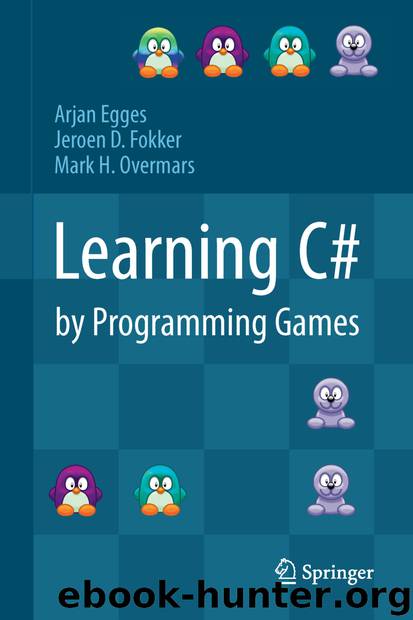Learning C# by Programming Games by Arjan Egges Jeroen D. Fokker & Mark H. Overmars

Author:Arjan Egges, Jeroen D. Fokker & Mark H. Overmars
Language: eng
Format: epub
Publisher: Springer Berlin Heidelberg, Berlin, Heidelberg
14.3.2 Relations Between Game Objects
If we want to establish a certain hierarchy between game objects, we need to identify which game object is a part of which other game object. In terms of hierarchies, this means that we need to establish that a game object can have a parent game object. For the game object itself, it is very useful to know who your parent is. Therefore, we need to store a GameObject variable that refers to the parent of the game object as well:
protected GameObject parent ;
For example, you can image that there is a object called ‘playing field’ that contains all the elements part of the playing field (jewels, row selection object, and so on). The ’playing field’ object can then be considered the parent of these elements. But not all game objects have a parent. For example, the root object does not have a parent. How can we indicate that a game object does not have a parent? We need to set the value of the parent member variable to ‘nothing’, or in C# programming terms: null.
parent = null ;
Now that we have added a parent to our game object class, we will have to deal with a few administrative hassles in order to make sure that the parent-child relationship between game objects is properly maintained, but we will get back to that later on. Because of this hierarchy of game objects, there are now a few things that we have to make decisions about.
Download
This site does not store any files on its server. We only index and link to content provided by other sites. Please contact the content providers to delete copyright contents if any and email us, we'll remove relevant links or contents immediately.
The Mikado Method by Ola Ellnestam Daniel Brolund(12292)
Hello! Python by Anthony Briggs(12183)
OCA Java SE 8 Programmer I Certification Guide by Mala Gupta(11550)
Algorithms of the Intelligent Web by Haralambos Marmanis;Dmitry Babenko(10150)
The Well-Grounded Java Developer by Benjamin J. Evans Martijn Verburg(9811)
Grails in Action by Glen Smith Peter Ledbrook(9479)
Secrets of the JavaScript Ninja by John Resig Bear Bibeault(9045)
Sass and Compass in Action by Wynn Netherland Nathan Weizenbaum Chris Eppstein Brandon Mathis(9032)
Test-Driven iOS Development with Swift 4 by Dominik Hauser(8437)
Windows APT Warfare by Sheng-Hao Ma(7784)
Kotlin in Action by Dmitry Jemerov(7738)
Layered Design for Ruby on Rails Applications by Vladimir Dementyev(7493)
Blueprints Visual Scripting for Unreal Engine 5 - Third Edition by Marcos Romero & Brenden Sewell(7408)
Solidity Programming Essentials by Ritesh Modi(4532)
Hands-On Full-Stack Web Development with GraphQL and React by Sebastian Grebe(4412)
WordPress Plugin Development Cookbook by Yannick Lefebvre(4346)
Unity 3D Game Development by Anthony Davis & Travis Baptiste & Russell Craig & Ryan Stunkel(4241)
Functional Programming in JavaScript by Mantyla Dan(4223)
The Ultimate iOS Interview Playbook by Avi Tsadok(4222)
